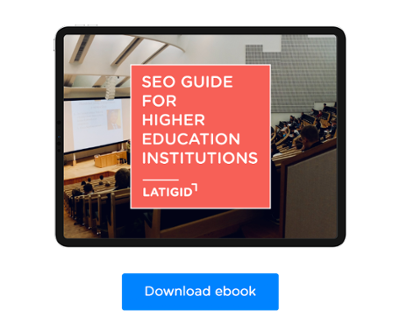
Many of the Universities use the notoriety they have managed to create nationally, complemented with visits to fairs, schools, and some targeted advertising to recruit their national students. The problem is that when you want to play in a global market you cannot use the same strategy. How to create notoriety in different markets? What fairs to visit? Where to advertise?
How can Universities generate leads from international students? There is an efficient formula called Inbound Marketing.
Instead of waiting for the materials that you will need to create to reach the students, or using intrusive advertising that, in addition to being ineffective, does not help your institution gain credibility, make sure your University is found online by the right students. Once you have the right traffic to your site, all you have to do is convert it into leads.
Follow the steps below and improve your capability to attract international students.
1. Define your student personas
Not all international students are equal or have the same motivations to study outside their home country. Before moving on to the different phases of inbound marketing, it is necessary to understand very well who our target is, going far beyond traditional demographic segmentation. In addition to understanding their countries of origin, it is equally important to understand their motivations, anxieties, how they seek information, and who helps them in the process. What are their goals? How can your institution help these students achieve them? What can prevent them from applying to your institution?
The elaboration of these student personas will be the basis of the entire inbound strategy. Think of the variety of people who visit your institution's website, whether they are high school students, parents, current students, alumni, adults looking for new skills, international students, or potential transfers. If these same people went to your institution, you probably wouldn't refer them to the same place and certainly, they wouldn't talk to the same people. You would probably tailor the experience to each person’s needs.
Your marketing must work the same way: different types of leads must have different experiences and receive different types of materials. The development of student personas will allow you to segment your approach, offering a personalized experience to different types of leads. To gain insight into your student personas talk to people in the admissions department and interview your current students.
2. Map the decision process
Now that we have defined the student personas, it is essential to understand the different stages of their decision-making process, which is not linear and has some distinct phases. The mapping of these phases is fundamental to any content strategy:
Awareness:
At this stage, the potential student is still defining the problem. He conducts more generic research on careers, forms of access, tests and exams;
Consideration:
At this stage, the student has already defined the problem and is actively researching all solutions for it;
Decision:
The student begins to evaluate and compare the different institutions that offer the solution chosen in the previous phase.
3. Attract traffic by creating and distributing content for the different stages of the decision process
Content will be the key to being found online. Use your institution's blog and website to answer the questions students are researching at different stages of the decision process. When writing content for the first two stages of the decision process, don't talk about yourself. Most students are not looking for you but for information to help them in their process. Focus on helping them. In this way, it starts to gain influence and credibility long before they are evaluating institutions.
Once you've chosen the topics you're going to write about, it's important to define the keywords you're going to compete for. Be smart about this choice, finding a balance between search volume and competition. Don't underestimate the importance of appearing at the top of search engine rankings. 80% of people just click on organic results.
In the end, disseminate these contents on social media, to increase its audience and guarantee that they reach those who matter. If the content offers value and helps potential students in their process, they are more likely to share on social media, ensuring that it reaches the people who matter most to you. In this way, the interested parties will naturally come to you, without intrusion, helping you to gain credibility with them. It is a more effective and efficient way than traditional means.
4. Convert traffic into leads through offers, calls-to-action, and landing pages
Now, it's time to convert your generated traffic into leads through conversion points. A conversion point is a place on your website where a visitor leaves their contact information and some personal data to access content or move to another level of interaction. This action is often promoted in a button where you click which is called call-to-action.
When looking at most institutions' websites, the most common CTAs (calls-to-action) are "Contact Us" or "Apply". The issue with these two CTAs is that they are somewhat limited. In the first, people only contact the institution at the last stage of the decision process. The second is the end of the decision process. Choosing a higher education institution is a life choice. Nobody applies after the first visit to an institution's website.
Get the contacts of your website visitors as soon as possible by placing offers with content related to the first stages of the decision process. These offers can be valuable e-books, guides, whitepapers, or checklists that students are willing to provide their contact information for. Look at conversion as an exchange. Personal data for valuable content. The greater the value of the content, the more data the visitor is willing to give in return.
With these 4 steps, you can start generating more leads for your institution. If you want to deepen your knowledge about inbound marketing methodology, I recommend you read this post. Any other questions, talk to us.





